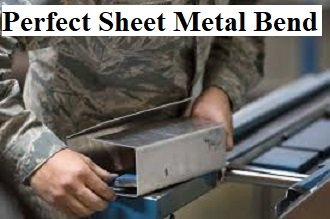Sheet metal fabrication comprises various processes that facilitate the shaping of the metal in the required form and size. CNC machining has long been used for shaping and structuring of metals. This may involve deburring, forming, cutting, bending, and many such processes depending upon the requirement. Sheet metal bending can be challenging when it comes to bending pipes or cylindrical rods. Also, depending upon the quantity required, this may be a repetitive task which also requires precision. Although technology has evolved to overcome these challenges of workmanship, materials and tools used needs to be precise to be able to achieve a perfect sheet metal bend. This post offers some tips for sheet metal bending.

perfect sheet metal bend
Tips to Achieve a Perfect Sheet Metal Bend
The bending process offers a new shape to the metals which may either become independent products or be used as a component in the final product. No matter what technology you use, the materials under consideration, the quality of machine and tools, and the lubrication factor are the most crucial elements when it comes to precision and quality in any sheet metal fabrication process. Here are some tips and pointers which may be helpful in achieving the right bend:
Bending can be achieved using different techniques depending upon the material used and the requirement. This includes air bending, rotary bending roll bending, coining, and so on.
The type of bending chosen depends on the shape required. For instance, roll bending is used for curved shapes, while elastomer bending is used for sensitive or delicate materials of any shape. It is also used on plain or finished surfaces.
For offset bends with odd shapes, joggle bending is used.
Press brake tools are used for air bending or coining to get the required precision.
The commonly used metals for bending are copper, aluminum, stainless steel, carbon steel, brass, or alloys of any of these metals.
Bending or tubes and pipes can be challenging. This can be achieved by using a servo motor and three-point bending process.
To achieve precision in tube and pipe bending, you need to know the physical properties of the material you are using. This includes the type of metal, its wall thickness, pipe or tube size or length, inner and outer diameter, and centerline radius.
It is also crucial that you know the wall thickness tolerance or the upper limit to avoid damage.
It is essential to know the bend radius so that the pipe or tube does not compress or stretch when pressure is applied.
When press brakes are used for bending, the metallic tube or pipe springs back, thus increasing the radial growth.
Usually, a tube made of hard material would have a low center radius.
The more the tube springs back the more would be the radial growth.
In welded tubes, if the joints are not aligned well, the shape or roundness of the tube may be affected.
In some cases, the tube or pipe may elongate during bending. Although the metal will resist elongation, the roundness of the outer surface may be affected making it a bit oval. Some amount of elongation may be acceptable in certain applications, but it will affect the precision value of that finished piece.
To achieve maximum precision, your tools must be appropriate and of good quality. So, make sure you have an updated and maintained toolkit.
Ensure you have hard, as well as soft sets of most tools. For instance, hard workpieces would require a soft mandrel and vice versa.
To achieve the right amount of precision in bending, the welding should be up to the mark with absolutely no issues in joints.
The way you place and use the tools during bending matters a lot. For instance, place the wiper die at the required angle. Same applies for the clamping die; it should be much longer than the tube diameter. It should clamp the workpiece without distorting its shape. So, when the clamp die is long enough the pressure applied by the clamp is held uniformly across the workpiece.
Your wiper dies and mandrels should be properly lubricated to avoid friction. You can use synthetic lubricants that are available in the market in the form of gel or paste.
You must upgrade your CNC machines to the ones that have multiple axes. For bending you may require a tooling space in the machine and up to 10 axes.
Are you looking for a reliable fabrication tools manufacturer who will understand your requirements and offer you amazing precision and quality in the stipulated timeframe? If yes, you can contact experienced sheet metal fabrication manufacturers such as Woodward Fab. They have a huge line of products such as rollers, benders, shearing tools, and so on that can suit your requirements. Woodward Fab is one of the leading suppliers and manufacturers of high-quality custom sheet metal fabrication tools and hand tools required across industries.
Post time: Aug-27-2021
